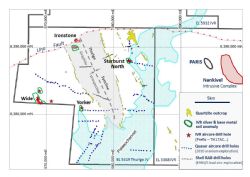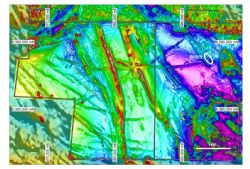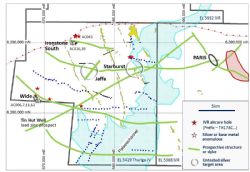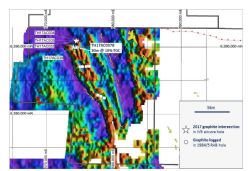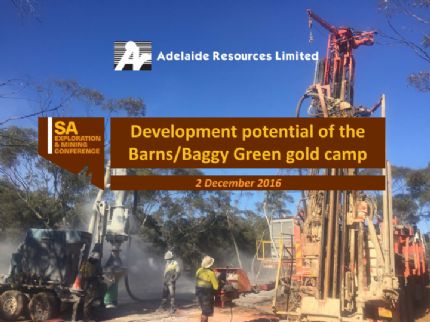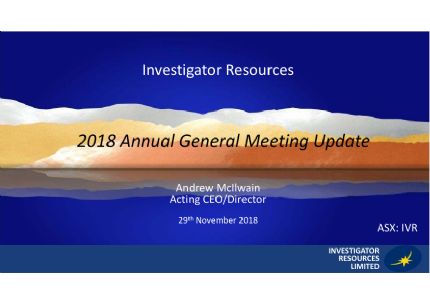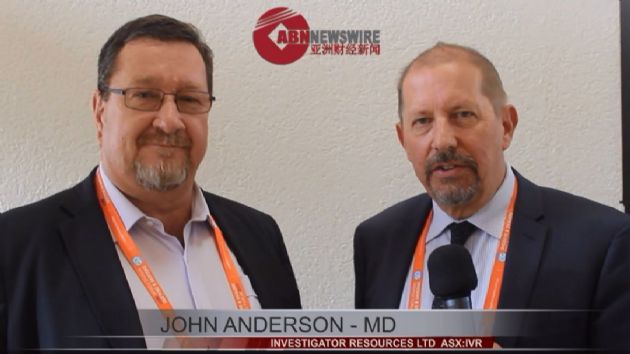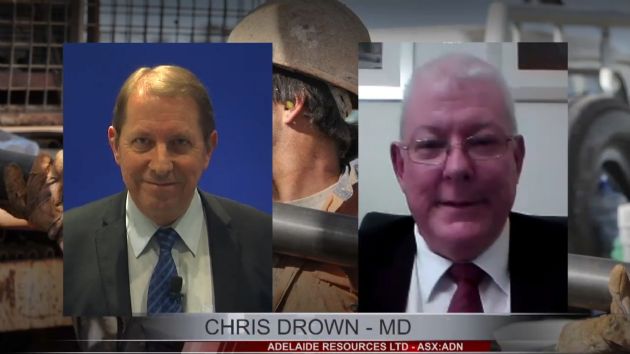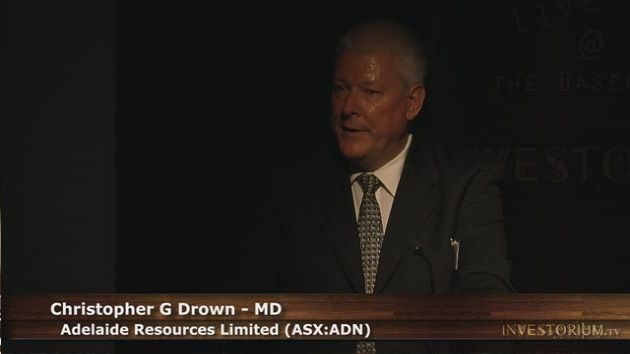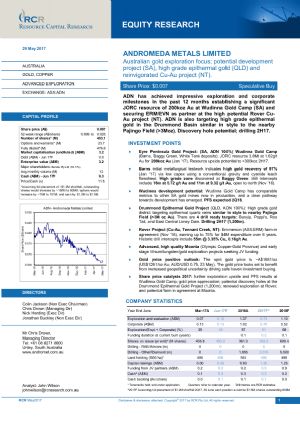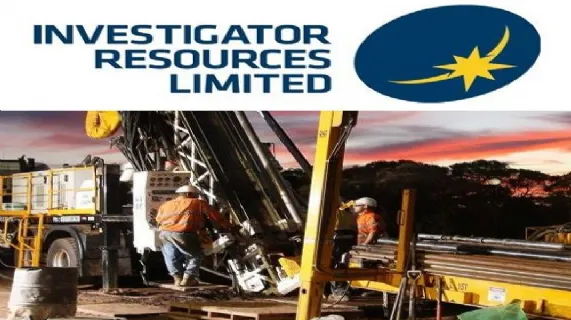
Investigator Earns 75% Equity in Thurlga Joint Venture
Adelaide, July 10, 2017 AEST (ABN Newswire) - Investigator Resources Limited ( ASX:IVR) undertook a scout drill program in March 2017 of 20 aircore holes totalling 1,076m of drilling with depths between 30m and 90m. The program primarily targeted soil anomalies for silver deposits similar to the Paris silver deposit located about 10km to the east in the adjacent 100% IVR-held tenement. The drilling and assays were completed under the Thurlga Joint Venture with Andromeda Metals Limited (
ASX:IVR) undertook a scout drill program in March 2017 of 20 aircore holes totalling 1,076m of drilling with depths between 30m and 90m. The program primarily targeted soil anomalies for silver deposits similar to the Paris silver deposit located about 10km to the east in the adjacent 100% IVR-held tenement. The drilling and assays were completed under the Thurlga Joint Venture with Andromeda Metals Limited ( ASX:ADN) and achieved the required expenditure for IVR to earn majority equity.
ASX:ADN) and achieved the required expenditure for IVR to earn majority equity.
- First pass aircore drilling of silver targets intersected:-
o Anomalous silver at two prospects to 6.6g/t silver.
o Broad intervals of graphite including 30m @ 10% Total Graphitic Carbon ("TGC") from 57m.
- Drilling supported by $41K State Government PACE funding.
Seven of the holes achieved anomalous silver and base metal results at two prospects, Wide and Ironstone South that will be evaluated along with new targeted structures extending from the Paris district.
The drilling also demonstrated prospective widths and grades of graphite mineralisation at one end of the 15km long basin-shaped Thurlga Syncline. Historical rotary air blast ("RAB") drilling by base metals explorer Shell Minerals on approximately 5km spaced traverses within the syncline intersected shallow visual graphite over broad widths. A prior airborne electromagnetic survey by uranium explorer Quasar maps up to 25km of conductive trends interpreted to be graphite-bearing horizons.
Investigator Resources Managing Director John Anderson said "Investigator has secured a strategic holding at Thurlga adjacent to our advancing Paris silver project. The initial drill results and new ideas from Paris are elevating the potential for silver targets at Thurlga along covered structures with poor surface signatures.
As another example of the under-explored and revitalised geology of the northern Eyre Peninsula, Investigator's drilling has also unveiled significant graphite potential that will be assessed as a secondary opportunity to the Company's silver and copper targeting." Mr Anderson added.
Investigator is pleased to report the results of the aircore drilling program, completed in March 2017 within the Thurlga tenement, EL5419. The exploration tenement is managed by Gawler Resources Limited, a wholly owned subsidiary of Investigator Resources, under Joint Venture with Peninsula Resources Limited, a wholly owned subsidiary of Andromeda Metals Limited. Gawler Resources Limited has recently earned 75% legal and beneficial interest in the joint venture after expenditure of A$750,000. Tenement transfer documents, reflecting IVR's earned equity, have been completed and lodged with the Minerals Branch of the Department of Premier and Cabinet.
The tenement adjoins the western margin of Investigator's 100% held Peterlumbo tenement containing the Paris Silver Project with a 42Moz Indicated and Inferred Mineral Resource, as well as the new generation of porphyry-related targets in the Nankivel intrusive complex (see Figure 1 in the link below). The drilling was co-funded as part of the South Australian Government's PACE drilling incentive scheme.
The aim of the drilling program was to test soil anomalies defined from the soil samples collected across the tenement, and to investigate the Uno Fault as a potential host for further silver mineralisation.
Four soil geochemical (silver, gold, copper and nickel) anomalies were identified from soil sampling at Wide, Yorker, Starburst North and Ironstone South (see Figure 1 in the link below).
In total, 20 aircore holes (1,076m; TH17AC005 to TH17AC044 (not inclusive)) were drilled, with depths of between 30m and 90m (average depth 54m); either vertically or at a 60deg dip (see Figure 1 & 3 and Table A in the link below).
Assay results have been received for the aircore holes drilled, with Table B summarising the metal intersections considered anomalous within the dataset. Total Graphitic Carbon ("TGC") was also analysed for holes with visible graphite content in the Ironstone area.
Silver targets
Silver and base metal anomalies were intersected at two prospects, Wide, in four holes and Ironstone South, in two holes, (see Figure 3 in the link below) with the targets open in most directions and being assessed for follow-up as possible halos to covered deposits.
At Wide, anomalous silver, lead, zinc and copper was achieved in four contiguous holes with the best being 28m @ 0.14% lead from 24m (TH17AC006), 1m @ 2.8g/t silver from 63m (end of hole, TH17AC007), 3m @ 456ppm copper from 36m (TH17AC011) and 21m @ 0.16% zinc and 1.05g/t silver from 36m (TH17AC012). These low-level anomalies may be indicative of dispersion halos from higher grade primary mineralisation nearby.
At Ironstone South, two adjacent holes (TH17AC036 and TH17AC039) intersected narrow 3m intervals of stronger silver anomalism.
At Ironstone North, four aircore holes (TH17AC032 to TH17AC035) were drilled in a traverse to locate and investigate the Uno Fault as a possible silver host where it adjoined the carbonate rocks considered the same as the basement of Hutchison Group carbonates to the Paris silver deposit. The fault was intersected without any encouraging signs of mineralisation and the traverse of holes hit the graphitic units of the Hutchison Group that host the graphite deposits elsewhere on Eyre Peninsula.
At Yorker, the single drillhole intersected thick gravels suggesting the soil anomaly there was transported and drilling was discontinued at that prospect.
At Starburst North, un-mineralised older basement rocks were intersected, downgrading the potential west of the lakes.
New targeting concepts developed at Paris and Nankivel have raised the prospectivity of the east-west dyke that is interpreted from the magnetics as extending from Paris into the Thurlga tenement (see Figures 2 & 3 in the link below).
Recent hole TH17AC043 at Ironstone (see Figure 3 in the link below) intersected the first volcanics south of the Uno Fault within the Thurlga tenement, adding to the potential for Paris and Nankivel-style deposits at the base of the volcanic pile. In addition, the Thurlga and adjacent synclines contain graphitic and dolomitic units that are the same prospective wall rocks that bound the Paris silver deposit.
Accordingly, the Jaffa and Starburst targets (see Figure 3 in the link below) are nominated as structurally prospective positions along the Paris dyke for further consideration with the possibility that Company's soil geochemistry had been ineffective there due to cover.
The Wide, Ironstone South, Jaffa and Starburst prospects will be further assessed for silver deposits using Investigator's latest targeting concepts for epithermal silver in the Paris district.
Graphite Discovery
Five aircore holes testing silver targets in the Ironstone area intersected substantial graphite with significant intersections up to 16.5% TGC in 3m composite samples. One broad interval achieved 30m @ 10% TGC. Figures 5, 6 and 7 (see the link below) show details of the hole geology and corresponding graphite assay results from Investigator's drilling.
The graphite potential of these good intersections is expanded by re-interpreting prior exploration work by other companies seeking different commodities; i.e. RAB drilling of magnetic units for lead-zinc in 1984 and the conductive formations mapped by a 2010 airborne electromagnetic survey for palaeochannel uranium. Drilling by Shell Minerals in 1984/5 targeted magnetic units for lead-zinc. The vertical RAB drilling ranged in depth from 6m to 18m with visible graphite described as shallow as one metre.
Figure 4 (see the link below) shows the general coincidence of extensive conductors with graphite in wide-spaced drilling and one small outcrop. Most of the prospective conductive trends do not have outcrop. The coarse drilling indicates the graphitic formations are up to 500m wide while the untested conductive trends aggregate up to 25km of strike potential.
The prospective host is the same regional stratigraphy on Eyre Peninsula that hosts Renascor Resources' Siviour Project, with a reported Mineral Resource of 80.6Mt @ 7.9% TGC for 6.4Mt of contained graphite, and Lincoln Minerals' Kookaburra Gully with a reported Mineral Resource of 2.2Mt at 15.1% TGC for 0.33Mt of contained graphite. The distribution of graphite deposits on Eyre Peninsula is shown in Figure 8 (see the link below).
The Thurlga Syncline is now considered by the Thurlga Joint Venture parties to have potential to be a significant graphite belt. Diverse structural settings may offer prospects for commercial graphite attributes. Samples from the recent drilling will provide preliminary evaluations of the graphite characteristics at the northern end of the extensive belt.
On-going work
The Joint Venture will be formalised and a program and budget will be developed for consideration of the Thurlga JV Management Committee.
To view tables and figures, please visit:
http://abnnewswire.net/lnk/34Y255KJ
About Investigator Resources Ltd
 Investigator Resources Limited (ASX:IVR) is a metals explorer with a focus on the opportunities for greenfields silver-lead, copper-gold and other metal discoveries in South Australia.
Investigator Resources Limited (ASX:IVR) is a metals explorer with a focus on the opportunities for greenfields silver-lead, copper-gold and other metal discoveries in South Australia.
The Company's priority is progressing the development pathway for the Paris silver project with the preparation of a pre-feasibility study. The Paris Mineral Resource Estimate is 9.3Mt @ 139g/t silver and 0.6% lead, comprising 42Moz of contained silver and 55kt of contained lead, at a 50g/t silver cut-off. The resource has been categorised with an Indicated Resource estimate of 4.3Mt @ 163g/t silver and 0.6% lead for 23Moz contained silver and 26kt contained lead, and an Inferred Resource: 5.0Mt @ 119g/t silver and 0.6% lead for 19Moz contained silver and 29kt contained lead.
The Company has applied an innovative strategy that has developed multiple ideas and targets giving Investigator first-mover status. These include: the Paris silver discovery; recognition of other epithermal fields and the associated potential for porphyry copper-gold of Olympic Dam age; extending the ideas developed at Paris-Nankivel and using breakthrough government Magneto-Telluric surveying to rejuvenate targeting with the Maslins IOCG target as the next priority drill target.
| ||
|



